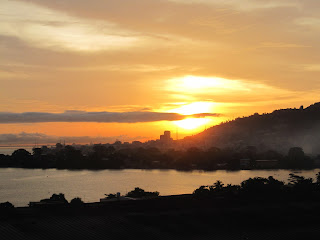Connaught Hospital is the
principal government hospital serving Freetown; it provides medical and
surgical care to the local population and is a tertiary referral centre for the
rest of the country. There are around
300 beds and the vast majority of admitted patients will pass through the
emergency department. Patients that
require admission are often incredibly sick, and the medical staff, many of
whom are volunteers often work under challenging circumstances. I’m constantly impressed by their positivity
and eagerness to do the best for their patients, despite the resource
limitations and lack of critical
infrastructure that exists within the healthcare system to manage the high
burden of disease here.
Malaria is incredibly common; the
WHO World Malaria Report quotes a figure of 1.7 million cases in 2013 (in a
population of 6 million) with over 4000 deaths.
The prevalence of HIV is quoted as around 1.5% although the hospital
prevalence is likely to be higher; many are newly diagnosed when they present
with advanced features of the disease, such as disseminated TB and neurological
complications such as toxoplasmosis and meningitis. In addition to the ‘big three’ infectious
diseases of TB, HIV and malaria; tetanus is not uncommon and typhoid is a
fairly frequent diagnosis, although the diagnostic limitations currently make
this a difficult disease to confirm.
I was expecting a high burden of
infectious disease in Sierra Leone but I have been surprised by the significant
degree of morbidity caused by non-communicable disease, much of which remains
undetected and undiagnosed. Patients are
not generally screened for diseases such as hypertension and diabetes and many
are often only diagnosed when they present with a complication such as a
stroke, heart failure or diabetic coma.
The other main group of patients
that present frequently to A&E in Connaught are victims of trauma. Injury accounts for 8% of all deaths in
Sierra Leone and the reasons for such a high figure are multi-factorial. Road traffic collisions are common and vehicle
safety often inadequate; it is a rarity to find a public vehicle with functioning
seat belts. Motorbikes weave in and out
of traffic on narrow crowded roads, dodging around unwary pedestrians; many
riders do not have helmets, let alone protective clothing, and it is a rarity
to see their passengers wearing one.
Emergency care is a small, but
increasingly important part of the overall picture. The healthcare system is fragile and
vulnerable, as recent experiences have proven.
In 2012, there were only 185 doctors serving the entire country and half
the country’s healthcare workers were based in the capital. This was pre-Ebola. Poverty is common and the cost of care and
hospital admission may bankrupt a family.
In 2010, the government introduced the Free Healthcare Initiative with
the aim of reducing maternal and child mortality rates and making progress
towards the Millennium Development Goals.
By offering free care to pregnant women, new mothers and children under
5, the country was making progress in improving what were some of the worst
mortality rates in the world. The situation
is undoubtedly worse now, however, the country is beginning to look forward
again.
The government have updated their
Basic Package of Essential Health Services with a focus on recovery and
building a resilient health system. The
goal is to provide efficient, cost-effective care that is available to all
Sierra Leoneans and it recognises Emergency Care as one of the essential
services. There will be a major focus on
maternal and child health but many of these deaths can be prevented by timely
and effective emergency care. Emergency
systems strengthening, including pre-hospital care will improve outcomes for
acutely sick and injured patients throughout the country but it will take time
and effort.
Each patient described previously
is based on a real case, and each has led to a great deal of reflection on how
their outcomes could be improved and how their presentations could be
prevented. It can feel a little
overwhelming at times. I am developing a
greater insight into how health systems function in general from my experience
here, and gaining an appreciation of how challenging it can be to make changes
that will have significant impact. I
have been in Sierra Leone for 3 months now, time is passing quickly and I am
still ascending a steep learning curve.
Healthcare is a complicated business!










